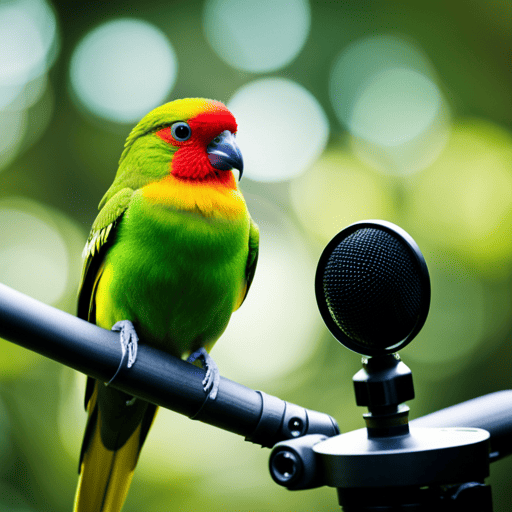Kakariki parrot are a popular pet bird due to their playful personality and vibrant colouring. But, can they talk like some of their larger parrot cousins? This question has intrigued bird enthusiasts for a long time and is still the subject of much speculation. In this article, we will explore their communication skills and investigate whether kakariki parrots have the ability to talk.
Can Kakariki Parrots Talk? Kakariki parrots have some capacity for speech. However, they’re not the best talkers compared to other parrot species. A kakariki may learn a few words or short phrases with persistent training. Their vocal abilities are more focused on whistling and making unique sounds.
Understanding Kakariki Parrots’ Natural Communication
Kakariki parrots are social and highly communicative creatures. They use a range of natural communication methods to interact with each other and their environment.
Vocalizations: One of the primary forms of communication amongst kakariki parrots is their vocalizations. They have a variety of calls that they use to convey different messages to each other, such as alarm calls, contact calls, and flock calls.
Body language: Another important aspect of communication among kakariki parrots is their body language. They use their body posture, head movements, and wing position to communicate with each other. For example, a lowered head or crouched posture can indicate submission, while an erect posture and raised wings can signal aggression or excitement.
Social interactions: Kakariki parrots are highly social and form close bonds with other members of their flock. They engage in a variety of social interactions, such as grooming, playing, and feeding each other, to reinforce these relationships and communicate their social status.
Understanding Kakariki Parrots’ Natural Communication
| Natural Communication Methods | Description |
|---|---|
| Vocalizations | A variety of calls used for different messages |
| Body language | Posture, head movements, wing position used to communicate |
| Social interactions | Grooming, playing, feeding to reinforce relationships and social status |
The Ability of Kakariki Parrots to Mimic Sounds
Kakariki parrots are known for their impressive ability to mimic sounds, including human speech. In the wild, they use this skill to communicate with their flock and imitate other birds’ songs and calls. However, in captivity, they can also learn to repeat words and phrases that they hear from their human caretakers.
The mimicry ability of kakariki parrots is a result of their unique vocal anatomy, which allows them to produce a wide range of sounds. They have a specialized vocal organ known as the syrinx, which enables them to create complex sounds and modulations.
Owners of kakariki parrots have shared numerous examples of their pets’ mimicry skills. Some parrots have learned to say simple words, like “hello” and “goodbye,” while others have developed a larger vocabulary and can imitate entire phrases. Some even have a unique style and tone of voice!
It is important to note that not all kakariki parrots will develop talking abilities, and it varies from bird to bird. Some may be more receptive to training, while others may not be as interested. Additionally, age can play a role in their learning ability, as younger birds may be more adaptable than older ones.
Overall, the mimicry ability of kakariki parrots is a fascinating trait that adds to their charm and personality. It is important to provide them with ample opportunities to interact with humans and other birds to enhance their communication skills.
Training Kakariki Parrots to Talk
Kakariki parrots are known for their impressive mimicry skills, but training them to talk like humans requires patience and consistent effort.
The first step in training a kakariki parrot to talk is building a strong bond with the bird. Parrots are social creatures and are more likely to mimic sounds and speech when they trust their owners and feel comfortable in their surroundings. Spend time with your parrot each day, talking to it gently and encouragingly.
Once your kakariki parrot is comfortable around you, you can start introducing it to words and phrases. Start with simple words and phrases like “hello” or the parrot’s name. Repeat the word or phrase clearly and consistently, using positive reinforcement such as treats or praise when the bird attempts to mimic the sound.
It’s important to be patient when training a kakariki parrot to talk. Some birds may take several months to start mimicking words, while others may never learn to talk. Avoid getting frustrated or discouraged if your parrot doesn’t seem to be making progress – remember that each bird is unique and learns at its own pace.
Finally, it’s worth noting that not all kakariki parrots have the ability or desire to talk. While some may excel at mimicry and enjoy learning new words and phrases, others may prefer to communicate through their natural vocalizations and body language. Respect your bird’s preferences and personality, and focus on building a strong bond built on trust and mutual respect.
Factors Affecting the Talking Ability of Kakariki Parrots
While kakariki parrots are known for their ability to mimic sounds, not all parrots have the same aptitude for talking. Factors influencing their ability to learn and speak include age, individual personality, and exposure to human speech.
Generally, younger kakariki parrots are more receptive to learning new sounds and words. Therefore, it is ideal to start training your parrot to talk at a young age. However, older birds can also be trained to talk with patience and persistence.
Personality is another factor that can impact a parrot’s ability to learn to talk. Some kakariki parrots are naturally more talkative and curious, while others are shy and reserved. Understanding your parrot’s personality can help you tailor your training techniques to their learning style.
Additionally, exposure to human speech is crucial for parrots to learn to talk. Parrots that live in a quiet environment with minimal human interaction may not develop good mimicking skills. Conversely, parrots that are consistently exposed to human speech have a better chance of learning to speak.
It is important to note that not all kakariki parrots will learn to talk, even with optimal training and exposure. Each parrot is unique; some may have a greater aptitude for mimicking sounds than others.
Other Forms of Communication in Kakariki Parrots
Besides their potential to mimic human speech, kakariki parrots have a range of other communication methods they use to interact with their environment.
Body language is a significant aspect of their non-verbal communication. For instance, when feeling aggressive, they will puff up their feathers and fan out their tail to appear more prominent. Similarly, when feeling relaxed, they will fluff out their feathers and lean forward, showing they are comfortable.
Kakariki parrots also use facial expressions to communicate. For example, when excited or alarmed, they will widen their eyes and open their beaks, emitting a screeching noise. Alternatively, they will close their eyes and make soft cooing sounds when content.
Furthermore, interaction with their environment is a vital way in which kakariki parrots communicate. They will examine their surroundings, play with toys, or explore new objects with their beaks, conveying their curiosity and interest.
Although they may not speak in words, kakariki parrots are incredibly skilled communicators. Owners of these birds often report that they develop unique communication methods specific to their individual bird’s personality and preferences.
Kakariki Parrot Talking Success Stories
There are many stories of kakariki parrots that have successfully learned to talk, bringing joy and entertainment to their owners.
“My kakariki, Kiwi, surprised me by saying ‘hello’ one day when I came home from work. I had no idea she had learned to talk! Now she greets me every day and even says ‘I love you’.”
Many owners have put in significant effort to train their kakariki parrots to talk, using positive reinforcement and repetition. Some have found that their parrots have a natural talent for mimicry, while others require more patience and persistence.
One owner shared their experience of teaching their kakariki, Mango, to talk:
“It took several months of consistent training, but Mango eventually learned to say ‘hello’, ‘pretty bird’, and ‘what’s up?’ He loves to show off his talking skills to anyone who visits.”
These success stories demonstrate the potential of kakariki parrots to learn and mimic human speech, providing hours of entertainment and companionship for their owners.
Can Kakariki Parrots Talk?: FAQs
Here are some frequently asked questions about kakariki parrots’ talking ability:
Can all kakariki parrots learn to talk?
While kakariki parrots have the ability to mimic human speech, not all individuals will develop this skill. Some will have a greater aptitude for learning and may pick up words and phrases more quickly than others.
At what age can I start training my kakariki parrot to talk?
You can start training your kakariki parrot to talk as soon as it is comfortable with you and its new environment. However, it is important to remember that younger birds may take longer to develop vocalizations and mimicry skills.
What is the best way to train my kakariki parrot to talk?
There are various techniques to train kakariki parrots to talk, including repetition of words and phrases, positive reinforcement, and gradual introduction of new words. It is important to be patient and consistent throughout the process.
Can my kakariki parrot learn to talk if it has never been exposed to human speech?
Kakariki parrots are able to learn vocalizations from a variety of sources, including other bird calls and environmental noises. However, exposure to human speech can enhance their ability to mimic and develop a wider vocabulary.
What are some limitations in training my kakariki parrot to talk?
Some kakariki parrots may not develop the ability to talk despite training efforts, while others may have limited vocabularies. It is important to remember that each bird is unique and may have its own learning pace and limitations.
How long does it take for a kakariki parrot to learn to talk?
The time it takes for a kakariki parrot to learn to talk varies from individual to individual. Some may start mimicking words and phrases within a few weeks, while others may take several months or longer to develop their skills.



Have comments or questions about this article? Then get involved!
Spotted an error or something we have missed? Let us know